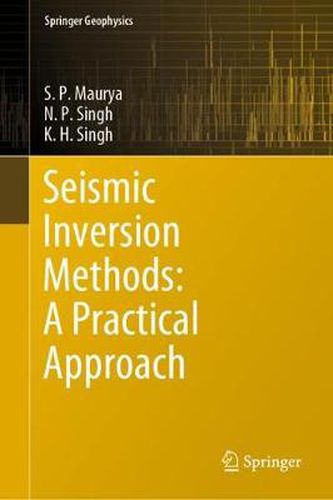Readings Newsletter
Become a Readings Member to make your shopping experience even easier.
Sign in or sign up for free!
You’re not far away from qualifying for FREE standard shipping within Australia
You’ve qualified for FREE standard shipping within Australia
The cart is loading…






This title is printed to order. This book may have been self-published. If so, we cannot guarantee the quality of the content. In the main most books will have gone through the editing process however some may not. We therefore suggest that you be aware of this before ordering this book. If in doubt check either the author or publisher’s details as we are unable to accept any returns unless they are faulty. Please contact us if you have any questions.
This book introduces readers to seismic inversion methods and their application to both synthetic and real seismic data sets. Seismic inversion methods are routinely used to estimate attributes like P-impedance, S-impedance, density, the ratio of P-wave and S-wave velocities and elastic impedances from seismic and well log data. These attributes help to understand lithology and fluid contents in the subsurface. There are several seismic inversion methods available, but their application and results differ considerably, which can lead to confusion. This book explains all popular inversion methods, discusses their mathematical backgrounds, and demonstrates their capacity to extract information from seismic reflection data. The types covered include model-based inversion, colored inversion, sparse spike inversion, band-limited inversion, simultaneous inversion, elastic impedance inversion and geostatistical inversion, which includes single-attribute analysis, multi-attribute analysis, probabilistic neural networks and multi-layer feed-forward neural networks. In addition, the book describes local and global optimization methods and their application to seismic reflection data. Given its multidisciplinary, integrated and practical approach, the book offers a valuable tool for students and young professionals, especially those affiliated with oil companies.
$9.00 standard shipping within Australia
FREE standard shipping within Australia for orders over $100.00
Express & International shipping calculated at checkout
This title is printed to order. This book may have been self-published. If so, we cannot guarantee the quality of the content. In the main most books will have gone through the editing process however some may not. We therefore suggest that you be aware of this before ordering this book. If in doubt check either the author or publisher’s details as we are unable to accept any returns unless they are faulty. Please contact us if you have any questions.
This book introduces readers to seismic inversion methods and their application to both synthetic and real seismic data sets. Seismic inversion methods are routinely used to estimate attributes like P-impedance, S-impedance, density, the ratio of P-wave and S-wave velocities and elastic impedances from seismic and well log data. These attributes help to understand lithology and fluid contents in the subsurface. There are several seismic inversion methods available, but their application and results differ considerably, which can lead to confusion. This book explains all popular inversion methods, discusses their mathematical backgrounds, and demonstrates their capacity to extract information from seismic reflection data. The types covered include model-based inversion, colored inversion, sparse spike inversion, band-limited inversion, simultaneous inversion, elastic impedance inversion and geostatistical inversion, which includes single-attribute analysis, multi-attribute analysis, probabilistic neural networks and multi-layer feed-forward neural networks. In addition, the book describes local and global optimization methods and their application to seismic reflection data. Given its multidisciplinary, integrated and practical approach, the book offers a valuable tool for students and young professionals, especially those affiliated with oil companies.